It is impossible to imagine an active and healthy lifestyle without movement. The joints are the most important element of the musculoskeletal system, which allows a person to move freely and feel full. With increasing age, dystrophy changes occur in bone and cartilage tissue, pain appears, which marks the onset of the disease.
The hip joint can withstand large loads throughout life, so it is not surprising that the most common ODA pathology is arthrosis-arthritis of the hip joint. From this article, you will learn what it is, as well as the causes, consequences and methods of treating coxarthrosis.
Features and causes
Coxarthrosis is a chronic inflammatory process in the hip joint, in which cartilage tissue undergoes premature destruction.
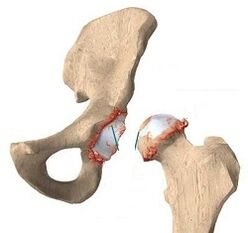
The development of this disease provokes osteophyte proliferation and melting of the acetabulum and femoral head, which narrows the joint space, the joint loses its function.
Let us explain that coxarthrosis is similar to arthrosis and osteoarthritis of the pelvic joint.
This disease can arise as a primary pathology or develop against the background of an existing disease.
Let us consider the main causes of coxarthrosis:
- during active or excessive physical activity (trauma, microtrauma, overload);
- congenital anomalies (dysplasia, Perthes disease, major joint deformity);
- pelvic bone inflammation (ankylosing spondylitis, rheumatoid or psoriatic arthritis);
- severe stress (spasm of blood vessels and muscles, aseptic necrosis, hypothermia);
- hormonal disorders; ischemic heart disease;
- Endocrine system diseases (obesity, diabetes mellitus).
Complex health problems lead to the development of coxarthrosis. Often, the disease is diagnosed in middle-aged and elderly people, however, with several provoking factors at the same time, young people and even children are prone to coxarthrosis.
Symptoms
To react in a timely manner to the development of pathology, it is important to look at the characteristic symptoms that change as arthrosis progresses.
The first and most important symptoms are pain in the legs, which penetrate the groin, gluteal muscles, sacrum, thighs and knees. Pain increases after physical exercise, by maintaining a long standing and sitting position.
Important! At first, the pain may be small and not at all visible in the pelvis, but, for example, in the knee. This fact complicates the initial diagnosis and correct diagnosis.
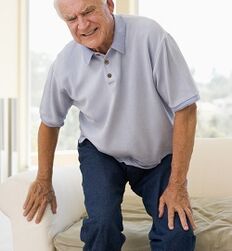
If the disease is not diagnosed in a timely manner, the patient will experience symptoms of hip arthrosis such as:
- severe pain in the groin while walking or resting on the legs;
- aching and rough pain when moving the hips to the side and walking (not to be confused with clicks, which are found in most healthy people);
- joint cramps, leg movement limitations;
- changes in walking style, lameness, duck walking style;
- shorten or lengthen limbs;
- muscle atrophy;
- foot fixtures in one position (ankylosis).
An important diagnostic sign of coxarthrosis is a physical limitation when bending forward, abducting the hips to the side.
A patient with this diagnosis finds it difficult to tie their own shoelaces, sit with separate feet, and sit inside.
There are 3 degrees of osteoarthritis of the acetabulum and femoral head, characterized by gradual destruction of the joints. Let's consider their features below.
Stage 1 coxarthrosis is characterized by slight destruction of cartilage, slightly narrowed joint space.
In the second stage, the destruction of cartilage tissue increases significantly, the first signs of the disease begin to interfere: pain, cramps.
More serious damage to the hip joint occurs in 3 stages. It is characterized by deep cartilage destruction, bone deformation, pain during rest. The disease completely damages the cartilage and damages the femur.
The joint loses its movement, the foot is glued and acts as a support. In this case, conservative therapy is helpless; surgical treatment with joint replacement is required.
Diagnostics
The diagnosis of the disease shows how severely the cartilage is affected and whether arthrosis of the hip joint can be cured.
The success of therapy depends on when treatment is started.
Notes. The last stage of coxarthrosis does not respond to conservative therapy and requires surgical intervention. Diagnosing and treating the disease in the early stages of the disease increases the chances of recovery.
To make a diagnosis, an external examination is performed, the degree of movement of the hip joint, changes in walking style and leg length are assessed. To confirm primary coxarthrosis, X-rays, CT and MRI are prescribed. If the patient needs surgical treatment, urine, feces, blood, and joint fluid are taken in addition.
Disease Treatment
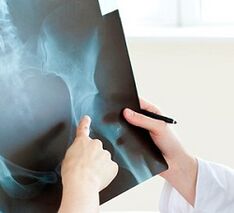
Coxarthrosis is a progressive disease. It is impossible to cure it once, such as an acute respiratory infection, and forget about the condition of your joints.
Successful treatment of grade 1, 2 and 3 hip joint arthrosis requires an integrated approach that combines therapeutic training, medications, physiotherapy, and patient lifestyle changes.
In extreme cases, patients should use coxarthrosis surgical treatment. The method of therapy depends on the stage of the disease.
Medicine
The first thing prescribed by patients diagnosed with osteoarthritis is a non-steroidal anti-inflammatory painkiller. They act directly on the site of inflammation and provide symptomatic treatment.
Note! It is important to observe the dosage and duration of the course indicated by the doctor. Uncontrolled use of NSAIDs leads to side effects.
For the treatment of coxarthrosis, vasodilators are also prescribed. They are needed to increase blood flow to diseased joints, to strengthen cartilage nutrition.
Chondroprotectors are used to restore cartilage movement and joint movement. Glucosamine and chondroitin sulfate are substances that stimulate the production of new building cells and inhibit the action of enzymes that destroy cartilage tissue.
Sort
Manual therapy or recovery massage is passive gymnastics for the affected joint. Thanks to massage movements, blood circulation and lymphatic drainage are improved, muscles are strengthened, ligaments and tendons become more elastic. This treatment approach helps to reduce pain, increase the effect of drug therapy and reduce the need for medication.
Important! Massage can only be performed by a qualified professional. Careless movement will cause more pain and injury to the joints.
Physiotherapy training
Movement is the foundation of life. Gymnastics for osteoarthritis of the hip bone aims to restore cartilage nutrition and joint movement, strengthening muscle corsets.
The performance of periodic recovery exercises leads to a decrease in leg discomfort while walking.
Gymnastics allows you to treat hip pain at home.
All movements are aimed at the treatment and prevention of stage 1 and 2 osteoarthritis of the hip joint.
Before starting training, make sure that there are no contraindications to training:
- hypertension;
- critical day;
- infectious diseases;
- increase in body temperature;
- recovery period after surgery on abdominal and chest organs;
- inguinal and umbilical hernia;
- herniated intervertebral disc;
- acute inflammatory processes of internal organs or exacerbation of chronic diseases;
- severe diseases of the cardiovascular and circulatory systems.
If while exercising, there is a movement that causes sharp pain, most likely, it does not suit you, so it is better not to do it and exclude it from the complex.
Diet
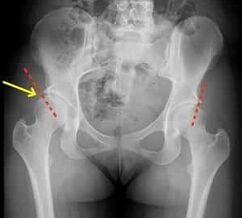
Diet therapy for hip joint arthrosis aims to reduce and maintain a normal weight.
Being overweight increases the load on the spine and joints, putting an additional risk of developing musculoskeletal system diseases.
The basis of the diet is the intake of simple foods rich in vitamins and minerals. Food should be intact and contain the necessary building blocks of cells: protein, carbohydrates, fats.
Plant foods should be preferred: nuts, seeds, leafy vegetables, seasonal vegetables and fruits, lean meats and fish, medium fat fermented dairy products, legumes and cereals.
Cow's milk is best drunk in moderation.
Fatty, spicy, smoked, canned, fried, pickled, semi-finished products, alcohol, coffee should be excluded from the diet.
Bad habits (smoking, drug addiction, overeating) should also be eliminated from your lifestyle, as they weaken the body, causing premature aging.
How to get rid of pain with folk remedies
Homeopathy for coxarthrosis of the hip joint is one of the alternative methods of therapy. Based on its natural components, homeopathy makes preparations aimed at treating the pathology of internal organs and the human skeleton. The specialty of homeopathic preparations for arthrosis is that they can restore the balance between the destruction of cartilage by enzymes and the renewal of tissues.
Attention! Before treating the hip joint at home, you need to undergo a diagnosis of the disease. It is important not to let the pathology get worse, as this can cause a person to walk.
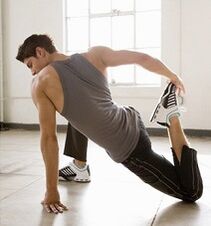
Homeopathic treatments, injections and ointments for joint treatment are selected based on the physical condition of the environment and the location of the disease.
Before using any medicine, you must see a doctor!
Prevention
People with this pathological predisposition should avoid stress, injury, treat infectious diseases in a timely manner, exercise regularly, eat well and get enough sleep.
If you experience discomfort in your legs, it is advisable to immediately contact an orthopedist for diagnosis and treatment.
Conclusion
Osteoarthritis of the hip joint most often affects people over the age of 45, athletes and children with congenital limb pathology. The disease damages and damages the joints, the person experiences severe pain in the legs. Successful treatment of coxarthrosis requires the participation of therapeutic exercises, medications, lifestyle and weight correction of the patient, and manual therapy.
Attention to health is the key to joint longevity! Do not delay a visit to an orthopedist at the first symptoms of the disease.












































